Apple 15-inch MacBook Pro (Late 2011) Review
by Anand Lal Shimpi on November 17, 2011 5:10 PM EST- Posted in
- Mac
- Apple
- Intel
- MacBook Pro
- Sandy Bridge
- Laptops
Display Quality
The display hasn't changed since earlier this year, although this is the first 15-inch 2011 MacBook Pro that I've tested with the standard resolution (1440 x 900), glossy panel. Aesthetically I prefer this panel (I'm the rare case that isn't bothered by gloss) and the lower resolution is easier on my eyes, but for productivity I do feel the 1680 x 1050 upgrade is worth it. If this is going to be a workhorse, and you have good eyesight, get the high-res version.
As always, Apple calibrates its panels at the factory. Note the out-of-the-box white point across the 11-inch MacBook Air, 13-inch MacBook Air and 15-inch MacBook Pro:
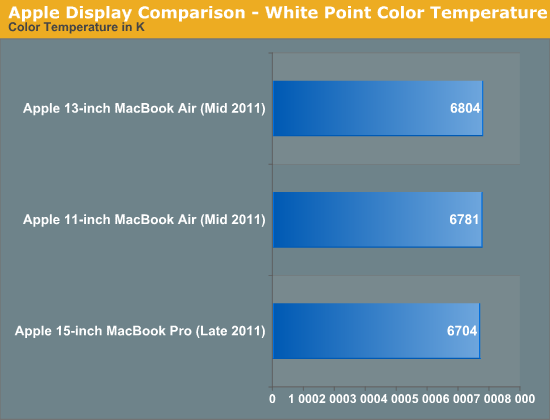
Apple wants to deliver as consistent of an experience as possible across its product line. While the Air models still don't have quite as high quality a panel as the Pro, at least there aren't any wide variations in what constitutes white on these panels.
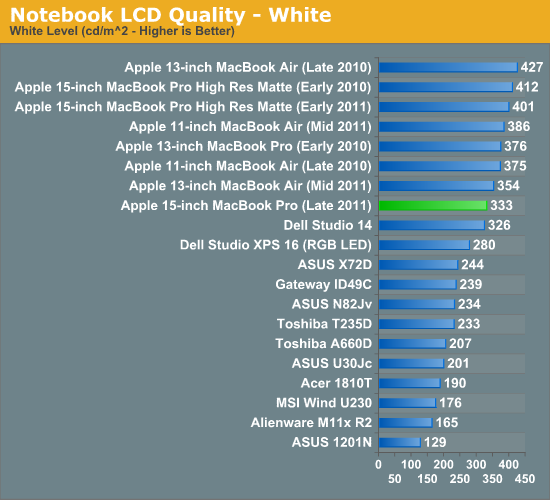
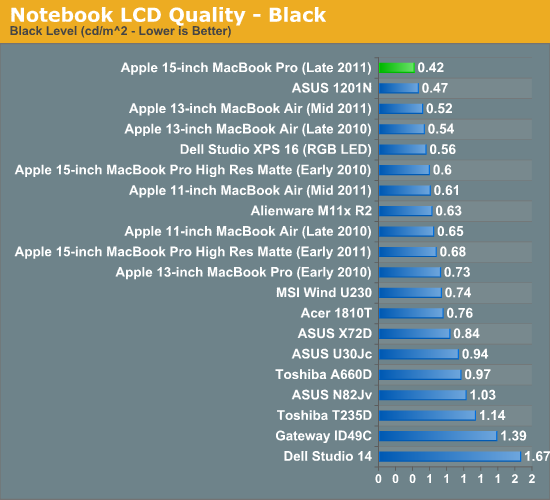
Brightness is down a bit compared to the high-res panel we looked at earlier this year, but so are black levels. The combination of the two actually results in a slightly higher contrast ratio than what we measured on the early 2011 models. In practice the panel looks just as good and seems to get just as blindingly bright as my personal 15-inch.
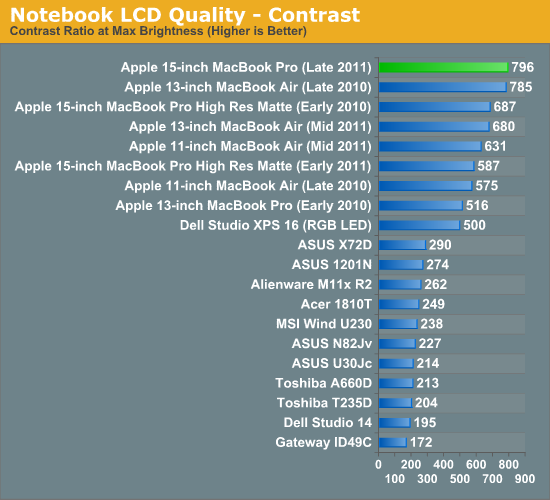
Color quality and gamut are virtually identical as well, no surprises here:
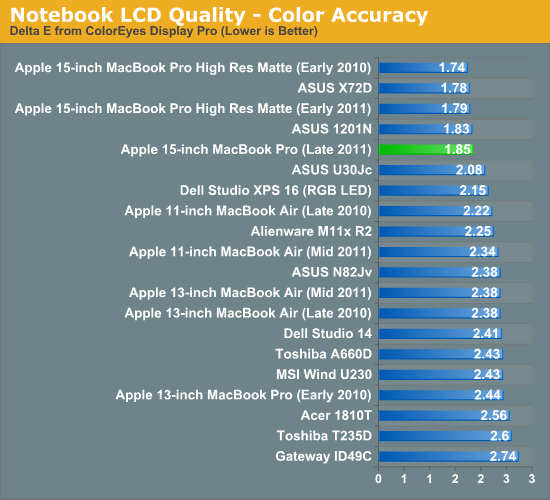

Hard Drive
The more traditional Macs (MBP, Mac Pro, iMac) continue to ship with mechanical hard drives by default, the late 2011 update is no different. My review sample came with a 5400RPM Toshiba MK5064GSXF. The drive features two 320GB platters (obviously not all in use for the 500GB capacity), and an 8MB cache.
All of my personal systems use SSDs and in testing the new MBP with a hard drive I can only say that the move back is more painful than ever. It's most noticeable when multitasking. Installing applications while browsing the web and copying files just seems to slow to a crawl compared to my SSD equipped MacBook Pro. If you're going to buy any new machine, especially if you're paying top dollar for something you expect to feel fast, you definitely need an SSD.

The good news is Apple's SSD pricing isn't horribly unreasonable, at least at the beginning. For $200 you can upgrade the 15-inch MacBook Pro to a 128GB drive (most likely a 3Gbps Samsung based SSD). It's when you look at the 256GB or larger drives that you're probably better off buying your own. You can buy a 256GB Crucial m4 for under $400 today, and a 240GB Vertex 3 will set you back around $460. Both options are cheaper (and faster) than Apple's $600 256GB upgrade. If you get the high-end 15-inch MBP model however, the upgrade prices drop by $100 - making the Apple route much more cost competitive. You don't get the same performance you would from an aftermarket drive, but with less headaches and potential for issues it's possibly a better route.
The 512GB drives are most definitely not a bargain from Apple. To equip a 15-inch MBP with a 512GB SSD, Apple wants $1200. You're much better off buying a 512GB Samsung SSD 830 for under $800 and pocketing the difference.
| Apple SSD Upgrade Pricing | |||||
| 128GB | 256GB | 512GB | |||
| 13-inch 2011 MacBook Pro | $200 | $600 | $1200 | ||
| 13-inch 2011 MacBook Pro (high end) | $100 | $500 | $1100 | ||
| 15-inch 2011 MacBook Pro | $200 | $600 | $1200 | ||
| 15-inch 2011 MacBook Pro (high end) | $100 | $500 | $1100 | ||
| 17-inch 2011 MacBook Pro | $100 | $500 | $1100 | ||
What aftermarket SSD should you buy? If you want to play it safe and hang on to TRIM support, go with Apple. Ever since I've been reviewed SSDs however I've run aftermarket SSDs in my Macs, mostly without any major issues. I can vouch for the Intel SSD 510, Samsung SSD 830 and OCZ Vertex 3. At one point or another I've used all of them in my 2011 MacBook Pro. My current setup is a Samsung 830 in the primary drive bay and an Intel SSD 510 in place of my optical drive, the combination works wonderfully.
Still Great WiFi
Apple continues to quietly focus on delivering excellent WiFi performance with the MacBook Pro. In the late 2011 models WiFi is still powered by Broadcom's BCM4331 3x3 solution. A quick test with a 3rd generation Time Capsule showed us peak transfer rates of 154Mbps, in line with what we've seen with the first generation Sandy Bridge MacBook Pro.

Despite Apple's move to Bluetooth 4.0 support on some of its other platforms, the MacBook Pro remains at 2.1 with the same BCM2070 controller.
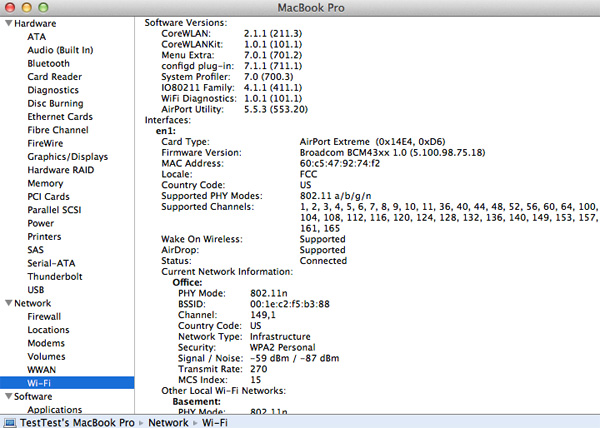


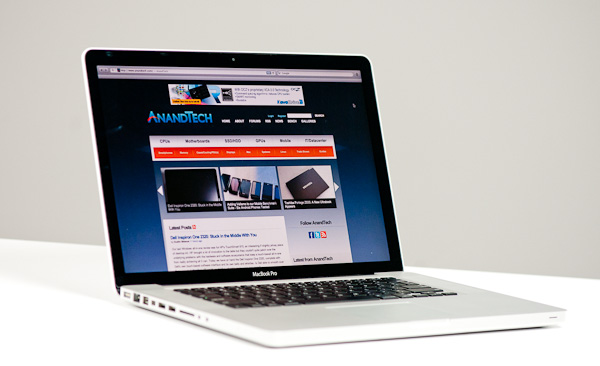








101 Comments
View All Comments
KoolAidMan1 - Friday, November 18, 2011 - link
You keep missing the point, the review is incidental, it's about the RAWR MAD responsesKoolAidMan1 - Friday, November 18, 2011 - link
Ok, did some Googling and found the actual article, I was wrong about both PCMag (it is PCWorld) and the generation (it is a 2007 Conroe MBP): http://www.pcworld.com/article/136649-3/in_picture..."The fastest Windows Vista notebook we've tested this year--or for that matter, ever--is a Mac. Not a Dell, not a Toshiba, not even an Alienware. The $2419 (plus the price of a copy of Windows Vista, of course) MacBook Pro's PC WorldBench 6 Beta 2 score of 88 beats Gateway's E-265M by a single point, but the MacBook's score is far more impressive simply because Apple couldn't care less whether you run Windows."
To be clear, this is less about it being the fastest notebook since the chassis limits the components you can put inside of it. If it was the fastest ever then it was only for a brief period. It again is about the outcry when a MBP gets a good review, that's all. This isn't rocket science, you see it here all the time. :)
ananduser - Sunday, November 20, 2011 - link
Stop using 2007 articles. Things change over time.KoolAidMan1 - Monday, November 21, 2011 - link
Herp derp, you miss the point, thus proving my point, congrats!arterius2 - Friday, November 18, 2011 - link
see this is exactly what i mean by spewing crap, the review on this page apparently shows that the 15" runs SC2 1440x900 on high at 32fps, this isnt even close to 1920x1080 yet, and its barely playable. the fact of the matter is, my 2 year old laptop can overtake performance of just released macbookpro at half the price (and it even comes with 8GB of ram vs 4GB of macbook).the only thing that makes the MBP "Fast" is its i7 processors, its memory/hdd/GPU are still light years away compared to the real high-end laptops. there are plenty of laptops that are designed to do real work for people that has real jobs.
when you use words such as "fastest" you better have shit to back it up, you are going to involve power users, and thats not what MBP are designed for, its designed for little high school girls. I feel sorry for these pathetic apple cultboys.
xype - Friday, November 18, 2011 - link
I am sure all the pathetic apple cultboys, like Anand, are going to be very hurt by your comments.Apple owns the laptop market. Deal with it.
arterius2 - Friday, November 18, 2011 - link
You've got to be kidding with a comment like that. Apple owns the laptop market? WHAAAT? where are you getting these numbers, show your sources, last time I've checked Apple's slogan was "We don't get viruses [because our market share is pretty much non-existent]"KoolAidMan1 - Friday, November 18, 2011 - link
First off, you're ignoring that the benchmark was 46fps using the dedicated GPU in OS X, but go right ahead and cherry pick data using Intel's integrated graphics instead.Seriously, CPU benchmark vs GPU benchmark, I thought people that came here knew how to read technical charts.
Second, my numbers are correct, I was running SC2 at high in Windows 7 on Boot Camp with the framerate showing via Ctrl-F. Perhaps you want a screenshot for proof next? I'm using the high end 2011 model which is slightly higher in benchmarks than the baseline model that this review tested. It is outputting to a 1920x1200 monitor but its native res is the upgraded 1680-by-1050 screen, so I've never even seen it at 1440x900.
The Radeon 6750M and 6770M are actually quite good high-midrange mobile GPUs, with the unreviewed 6770M not too far off from an 460M. Yeah you could get a faster GPU in another laptop, but the result is a 8lb+ 2" thick behemoth with an hour of battery life. Some people don't want massive laptops with no battery life. The MBP is an excellent balance between high performance, long battery life, and a slim/light enclosure, plus you get the awesome display, etc etc.
As for "fastest", I addressed that above. I gave an example where fanboys went crazy when PCMag called the first Penryn Macbook Pro the fastest PC laptop around, and for that period it actually was. I didn't say it is CURRENTLY the fastest laptop around, that's ludicrous.
I was using the story as an example where anti-Apple fanboys go nuts if you even dare say that the hardware is any good. You proved my point perfectly while making a fool of yourself. Thank you.
ananduser - Sunday, November 20, 2011 - link
There are moments in SC2, if you play let's say 3v3 or 4v4, when the combined graphical artifacts that have to be rendered pushes the machine(especially a laptop) pretty hard, so your 46FPS might vary.But still SC2 is not a demanding game, Blizzard is not famous for cutting edge graphics, great gameplay and extremely refined cinematics instead.
Anyway, the MBP has GOOD hardware, no one denied that, BUT it could be better. Since moving to Intel gear Apple has had moments when its laptops were cutting edge. And that was when Intel introduced its brand new cpus, usually exclusively on Apple gear first through exclusivity agreements, thus shafting the other manufacturers from a marketing point of view.
Sorry for hijacking your argument, just pointed a few nitpicks.
KoolAidMan1 - Monday, November 21, 2011 - link
It could absolutely have better hardware, no question. The problem is that it would result in a larger chassis, reduced battery life, or both. As it stands the current CPU/GPU are just acceptable for a MBP, go anything higher and you'll deal with overheating components or reduced battery life.It's a concession that people knowingly make. If someone wanted more GPU, they'd get a larger laptop (such as the excellent Asus mentioned) with more cooling and less battery life, simple.
It's actually ok, my 2011 MBP runs SC2, Diablo 3 beta, and DOTA 2 *perfectly* even outputting to a 24" monitor, so no complaints. If you want more for something like BF3, bigger laptop.
That's what my SLI desktop is for anyway and I want a light but powerful laptop with lots of battery life, so yeah. :)